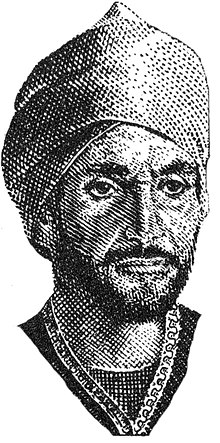Abu Tammam
Ḥabīb ibn Aws al-Ṭā’ī | |
|---|---|
 | |
| Native name | حبيب بن أوس الطائي |
| Born | ca. 796/807 AD Jasim |
| Died | 845 AD Mosul |
| Pen name | Abū Tammām |
| Language | Arabic |
| Period | Islamic Golden Age (Abbasid era) |
Ḥabīb ibn Aws
Biography
Abu Tammam was born in Syria near
He seems to have spent his youth in Homs, though, according to one story, he was employed during his boyhood selling water at a mosque in Cairo. His first appearance as a poet was in Egypt, but as he failed to make a living there he went to Damascus, and then to Mosul.[2] From there he sought patronage from the Syria-based caliph al-Ma'mun of the Abbasid Caliphate, but failed to impress him.
He then traveled towards the eastern part of the caliphate, eventually gaining admirers and patrons by praising various officials, such as the governor of
Abu Tammam is best known in literature by his 9th-century compilation of early poems known as the
The famous poet al-Buhturi, who was a student and contemporary of Abu Tammâm, was also a member of the Tay' tribe. In Arabic literature, these two poets have often been compared with each other. Generally, Abu Tammâm is accepted as the representative of the artificial (masnû') poetry style. On the other hand, his student al-Buhturî is generally regarded as the representative of the natural (matbû‘) poetry genre.
Two other collections of a similar nature are ascribed to Abu Tammam. His own poems have been somewhat neglected owing to the success of his compilations, but they enjoyed great repute in his lifetime. His poems reflect a stylistic break from prevailing oral-based concepts of Arab poetry,[9] often describing historical events and people. They were distinguished for the purity of their style, the merit of the verse, and the excellent manner of treating subjects,[2] and have been linked to the prevailing Mutazilite philosophy of the Abbasid period.[8] His poems were published in Cairo in 1875.
According to the poet
References
- ^ Ibn Ab̄i Tahir Ṭāyfūr and Arabic writerly culture a ninth-century bookman in Baghdad, Routledge Curzon Studies in Arabic and Middle-Eastern Literatures: A Ninth-century Bookman in Baghdad, By Shawkat M. Toorawa, pg. 94
- ^ a b c d One or more of the preceding sentences incorporates text from a publication now in the public domain: Chisholm, Hugh, ed. (1911). "Abu Tammam". Encyclopædia Britannica. Vol. 1 (11th ed.). Cambridge University Press. p. 81.
- ^ "Hamasah of Abu Tammam". archiveshub.jisc.ac.uk.
- ^ "Abū Tammām: Syrian poet". Britannica.
- ^ Najashi, Ahmad bin Ali. Rijal of al-Najashi. p. 141.
- .
- ^ Adonis. An Introduction to Arab Poetics, Saqi Books, 1990. pg. 43
- ^ a b Julie Meisami and Paul Starkey. Encyclopedia of Arabic Literature. Routledge, 1998. pg. 48
- ^ a b Adonis. An Introduction to Arab Poetics, Saqi Books, 1990. pg. 50
